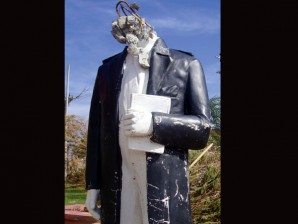
A STATUE of national hero Jose Rizal in Baganga, Davao Oriental, was not spared by Typhoon “Pablo” which, while leaving the image standing, blew off its head. NICO ALCONABA/INQUIRER MINDANAO
CITY OF SAN FERNANDO – Dr. Jose Rizal might just give the Philippines a strong push for cultural tourism, a top official of the National Commission for Culture and the Arts (NCCA) said.
Felipe de Leon Jr., NCCA chairman, thinks so because the national hero is excellence personified, a facet of cultural worth.
“As far as tourism is concerned, excellence is a sure winner,” De Leon said in his keynote address at the Icomos international conference on cultural tourism in Vigan City in November.
Icomos stands for the International Council on Monuments and Sites, a non-government organization of professionals whose goal is to preserve the world’s historic monuments and sites.
“A phenomenon characterized by so much excellence, and one that we could surely have capitalized upon to catapult Filipino prestige sky high, as our Edsa Revolution once did, is the ever-fascinating and inexhaustible force that is Jose Rizal,” De Leon told some 500 cultural advocates from the United States, Europe, Asia and the Philippines.
Sadly, however, Filipinos have not been able to capitalize on Rizal’s greatness, he said.
“Filipino ideologues still pit [Katipunan leader Andres] Bonifacio against Rizal or denigrate Rizal as an American-sponsored hero, a notion that is historically nonsensical,” De Leon said.
Rizal, he said, inspired the first revolution against western colonialism in Asia.
“Why is he not well known to the world as [Indian nationalist Mahatma] Gandhi, [Chinese revolutionary] Sun Yat Sen and [Indian poet Rabindranath] Tagore is the Filipinos’ fault,” he said.
Rizal, he said, fought for the “freedom of the creative human spirit, social justice and equality.”
De Leon said cultural tourism could profit from items made from Rizal’s works, such as houses, songs, booklets or cards of his poetry and thoughts.
Photos and images of Rizal and his life would be sought after by visitors, he said.
The same can be done of other Philippine heroes and historical figures, he said.
“More than beaches and resorts, it is really the distinctive cultural and historical landmarks that attract tourists to a place,” he said.
“A serious program for cultural tourism demands that we understand and appreciate our cultural strengths,” he said.
Architect Augusto Villalon, head of Icomos Philippines, said the conference seeks to help Filipinos meld culture and tourism for community development.
Susan Millar, Icomos International head, said a key element of cultural tourism follows the thought that “people like seeing people.”